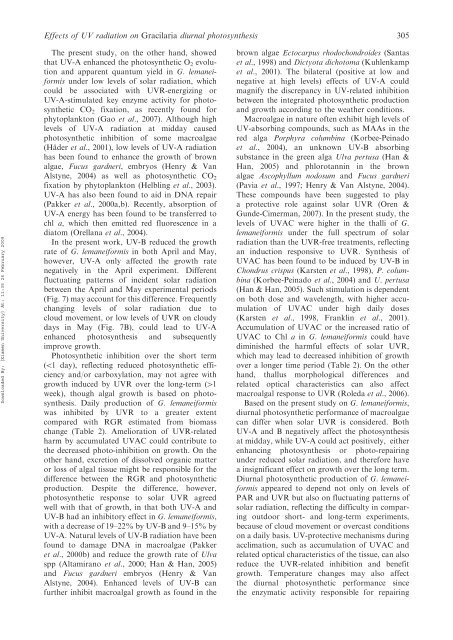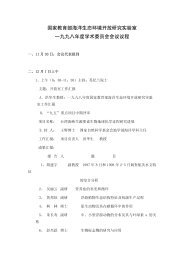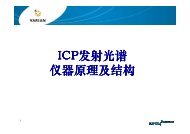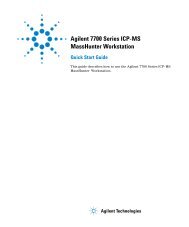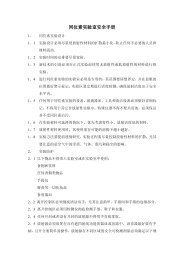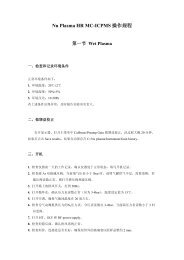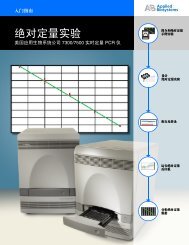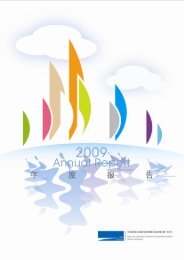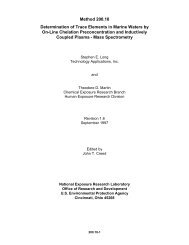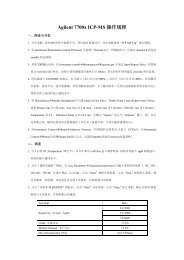Effects of solar UV radiation on diurnal photosynthetic performance ...
Effects of solar UV radiation on diurnal photosynthetic performance ...
Effects of solar UV radiation on diurnal photosynthetic performance ...
You also want an ePaper? Increase the reach of your titles
YUMPU automatically turns print PDFs into web optimized ePapers that Google loves.
<str<strong>on</strong>g>Effects</str<strong>on</strong>g> <str<strong>on</strong>g>of</str<strong>on</strong>g> <str<strong>on</strong>g>UV</str<strong>on</strong>g> <str<strong>on</strong>g>radiati<strong>on</strong></str<strong>on</strong>g> <strong>on</strong> Gracilaria <strong>diurnal</strong> photosynthesis 305<br />
Downloaded By: [Xiamen University] At: 11:35 26 February 2009<br />
The present study, <strong>on</strong> the other hand, showed<br />
that <str<strong>on</strong>g>UV</str<strong>on</strong>g>-A enhanced the <strong>photosynthetic</strong> O 2 evoluti<strong>on</strong><br />
and apparent quantum yield in G. lemaneiformis<br />
under low levels <str<strong>on</strong>g>of</str<strong>on</strong>g> <str<strong>on</strong>g>solar</str<strong>on</strong>g> <str<strong>on</strong>g>radiati<strong>on</strong></str<strong>on</strong>g>, which<br />
could be associated with <str<strong>on</strong>g>UV</str<strong>on</strong>g>R-energizing or<br />
<str<strong>on</strong>g>UV</str<strong>on</strong>g>-A-stimulated key enzyme activity for <strong>photosynthetic</strong><br />
CO 2 fixati<strong>on</strong>, as recently found for<br />
phytoplankt<strong>on</strong> (Gao et al., 2007). Although high<br />
levels <str<strong>on</strong>g>of</str<strong>on</strong>g> <str<strong>on</strong>g>UV</str<strong>on</strong>g>-A <str<strong>on</strong>g>radiati<strong>on</strong></str<strong>on</strong>g> at midday caused<br />
<strong>photosynthetic</strong> inhibiti<strong>on</strong> <str<strong>on</strong>g>of</str<strong>on</strong>g> some macroalgae<br />
(Häder et al., 2001), low levels <str<strong>on</strong>g>of</str<strong>on</strong>g> <str<strong>on</strong>g>UV</str<strong>on</strong>g>-A <str<strong>on</strong>g>radiati<strong>on</strong></str<strong>on</strong>g><br />
has been found to enhance the growth <str<strong>on</strong>g>of</str<strong>on</strong>g> brown<br />
algae, Fucus gardneri, embryos (Henry & Van<br />
Alstyne, 2004) as well as <strong>photosynthetic</strong> CO 2<br />
fixati<strong>on</strong> by phytoplankt<strong>on</strong> (Helbling et al., 2003).<br />
<str<strong>on</strong>g>UV</str<strong>on</strong>g>-A has also been found to aid in DNA repair<br />
(Pakker et al., 2000a,b). Recently, absorpti<strong>on</strong> <str<strong>on</strong>g>of</str<strong>on</strong>g><br />
<str<strong>on</strong>g>UV</str<strong>on</strong>g>-A energy has been found to be transferred to<br />
chl a, which then emitted red fluorescence in a<br />
diatom (Orellana et al., 2004).<br />
In the present work, <str<strong>on</strong>g>UV</str<strong>on</strong>g>-B reduced the growth<br />
rate <str<strong>on</strong>g>of</str<strong>on</strong>g> G. lemaneiformis in both April and May,<br />
however, <str<strong>on</strong>g>UV</str<strong>on</strong>g>-A <strong>on</strong>ly affected the growth rate<br />
negatively in the April experiment. Different<br />
fluctuating patterns <str<strong>on</strong>g>of</str<strong>on</strong>g> incident <str<strong>on</strong>g>solar</str<strong>on</strong>g> <str<strong>on</strong>g>radiati<strong>on</strong></str<strong>on</strong>g><br />
between the April and May experimental periods<br />
(Fig. 7) may account for this difference. Frequently<br />
changing levels <str<strong>on</strong>g>of</str<strong>on</strong>g> <str<strong>on</strong>g>solar</str<strong>on</strong>g> <str<strong>on</strong>g>radiati<strong>on</strong></str<strong>on</strong>g> due to<br />
cloud movement, or low levels <str<strong>on</strong>g>of</str<strong>on</strong>g> <str<strong>on</strong>g>UV</str<strong>on</strong>g>R <strong>on</strong> cloudy<br />
days in May (Fig. 7B), could lead to <str<strong>on</strong>g>UV</str<strong>on</strong>g>-A<br />
enhanced photosynthesis and subsequently<br />
improve growth.<br />
Photosynthetic inhibiti<strong>on</strong> over the short term<br />
(51 day), reflecting reduced <strong>photosynthetic</strong> efficiency<br />
and/or carboxylati<strong>on</strong>, may not agree with<br />
growth induced by <str<strong>on</strong>g>UV</str<strong>on</strong>g>R over the l<strong>on</strong>g-term (41<br />
week), though algal growth is based <strong>on</strong> photosynthesis.<br />
Daily producti<strong>on</strong> <str<strong>on</strong>g>of</str<strong>on</strong>g> G. lemaneiformis<br />
was inhibited by <str<strong>on</strong>g>UV</str<strong>on</strong>g>R to a greater extent<br />
compared with RGR estimated from biomass<br />
change (Table 2). Ameliorati<strong>on</strong> <str<strong>on</strong>g>of</str<strong>on</strong>g> <str<strong>on</strong>g>UV</str<strong>on</strong>g>R-related<br />
harm by accumulated <str<strong>on</strong>g>UV</str<strong>on</strong>g>AC could c<strong>on</strong>tribute to<br />
the decreased photo-inhibiti<strong>on</strong> <strong>on</strong> growth. On the<br />
other hand, excreti<strong>on</strong> <str<strong>on</strong>g>of</str<strong>on</strong>g> dissolved organic matter<br />
or loss <str<strong>on</strong>g>of</str<strong>on</strong>g> algal tissue might be resp<strong>on</strong>sible for the<br />
difference between the RGR and <strong>photosynthetic</strong><br />
producti<strong>on</strong>. Despite the difference, however,<br />
<strong>photosynthetic</strong> resp<strong>on</strong>se to <str<strong>on</strong>g>solar</str<strong>on</strong>g> <str<strong>on</strong>g>UV</str<strong>on</strong>g>R agreed<br />
well with that <str<strong>on</strong>g>of</str<strong>on</strong>g> growth, in that both <str<strong>on</strong>g>UV</str<strong>on</strong>g>-A and<br />
<str<strong>on</strong>g>UV</str<strong>on</strong>g>-B had an inhibitory effect in G. lemaneiformis,<br />
with a decrease <str<strong>on</strong>g>of</str<strong>on</strong>g> 19–22% by <str<strong>on</strong>g>UV</str<strong>on</strong>g>-B and 9–15% by<br />
<str<strong>on</strong>g>UV</str<strong>on</strong>g>-A. Natural levels <str<strong>on</strong>g>of</str<strong>on</strong>g> <str<strong>on</strong>g>UV</str<strong>on</strong>g>-B <str<strong>on</strong>g>radiati<strong>on</strong></str<strong>on</strong>g> have been<br />
found to damage DNA in macroalgae (Pakker<br />
et al., 2000b) and reduce the growth rate <str<strong>on</strong>g>of</str<strong>on</strong>g> Ulva<br />
spp (Altamirano et al., 2000; Han & Han, 2005)<br />
and Fucus gardneri embryos (Henry & Van<br />
Alstyne, 2004). Enhanced levels <str<strong>on</strong>g>of</str<strong>on</strong>g> <str<strong>on</strong>g>UV</str<strong>on</strong>g>-B can<br />
further inhibit macroalgal growth as found in the<br />
brown algae Ectocarpus rhodoch<strong>on</strong>droides (Santas<br />
et al., 1998) and Dictyota dichotoma (Kuhlenkamp<br />
et al., 2001). The bilateral (positive at low and<br />
negative at high levels) effects <str<strong>on</strong>g>of</str<strong>on</strong>g> <str<strong>on</strong>g>UV</str<strong>on</strong>g>-A could<br />
magnify the discrepancy in <str<strong>on</strong>g>UV</str<strong>on</strong>g>-related inhibiti<strong>on</strong><br />
between the integrated <strong>photosynthetic</strong> producti<strong>on</strong><br />
and growth according to the weather c<strong>on</strong>diti<strong>on</strong>s.<br />
Macroalgae in nature <str<strong>on</strong>g>of</str<strong>on</strong>g>ten exhibit high levels <str<strong>on</strong>g>of</str<strong>on</strong>g><br />
<str<strong>on</strong>g>UV</str<strong>on</strong>g>-absorbing compounds, such as MAAs in the<br />
red alga Porphyra columbina (Korbee-Peinado<br />
et al., 2004), an unknown <str<strong>on</strong>g>UV</str<strong>on</strong>g>-B absorbing<br />
substance in the green alga Ulva pertusa (Han &<br />
Han, 2005) and phlorotannin in the brown<br />
algae Ascophyllum nodosum and Fucus gardneri<br />
(Pavia et al., 1997; Henry & Van Alstyne, 2004).<br />
These compounds have been suggested to play<br />
a protective role against <str<strong>on</strong>g>solar</str<strong>on</strong>g> <str<strong>on</strong>g>UV</str<strong>on</strong>g>R (Oren &<br />
Gunde-Cimerman, 2007). In the present study, the<br />
levels <str<strong>on</strong>g>of</str<strong>on</strong>g> <str<strong>on</strong>g>UV</str<strong>on</strong>g>AC were higher in the thalli <str<strong>on</strong>g>of</str<strong>on</strong>g> G.<br />
lemaneiformis under the full spectrum <str<strong>on</strong>g>of</str<strong>on</strong>g> <str<strong>on</strong>g>solar</str<strong>on</strong>g><br />
<str<strong>on</strong>g>radiati<strong>on</strong></str<strong>on</strong>g> than the <str<strong>on</strong>g>UV</str<strong>on</strong>g>R-free treatments, reflecting<br />
an inducti<strong>on</strong> resp<strong>on</strong>sive to <str<strong>on</strong>g>UV</str<strong>on</strong>g>R. Synthesis <str<strong>on</strong>g>of</str<strong>on</strong>g><br />
<str<strong>on</strong>g>UV</str<strong>on</strong>g>AC has been found to be induced by <str<strong>on</strong>g>UV</str<strong>on</strong>g>-B in<br />
Ch<strong>on</strong>drus crispus (Karsten et al., 1998), P. columbina<br />
(Korbee-Peinado et al., 2004) and U. pertusa<br />
(Han & Han, 2005). Such stimulati<strong>on</strong> is dependent<br />
<strong>on</strong> both dose and wavelength, with higher accumulati<strong>on</strong><br />
<str<strong>on</strong>g>of</str<strong>on</strong>g> <str<strong>on</strong>g>UV</str<strong>on</strong>g>AC under high daily doses<br />
(Karsten et al., 1998, Franklin et al., 2001).<br />
Accumulati<strong>on</strong> <str<strong>on</strong>g>of</str<strong>on</strong>g> <str<strong>on</strong>g>UV</str<strong>on</strong>g>AC or the increased ratio <str<strong>on</strong>g>of</str<strong>on</strong>g><br />
<str<strong>on</strong>g>UV</str<strong>on</strong>g>AC to Chl a in G. lemaneiformis could have<br />
diminished the harmful effects <str<strong>on</strong>g>of</str<strong>on</strong>g> <str<strong>on</strong>g>solar</str<strong>on</strong>g> <str<strong>on</strong>g>UV</str<strong>on</strong>g>R,<br />
which may lead to decreased inhibiti<strong>on</strong> <str<strong>on</strong>g>of</str<strong>on</strong>g> growth<br />
over a l<strong>on</strong>ger time period (Table 2). On the other<br />
hand, thallus morphological differences and<br />
related optical characteristics can also affect<br />
macroalgal resp<strong>on</strong>se to <str<strong>on</strong>g>UV</str<strong>on</strong>g>R (Roleda et al., 2006).<br />
Based <strong>on</strong> the present study <strong>on</strong> G. lemaneiformis,<br />
<strong>diurnal</strong> <strong>photosynthetic</strong> <strong>performance</strong> <str<strong>on</strong>g>of</str<strong>on</strong>g> macroalgae<br />
can differ when <str<strong>on</strong>g>solar</str<strong>on</strong>g> <str<strong>on</strong>g>UV</str<strong>on</strong>g>R is c<strong>on</strong>sidered. Both<br />
<str<strong>on</strong>g>UV</str<strong>on</strong>g>-A and B negatively affect the photosynthesis<br />
at midday, while <str<strong>on</strong>g>UV</str<strong>on</strong>g>-A could act positively, either<br />
enhancing photosynthesis or photo-repairing<br />
under reduced <str<strong>on</strong>g>solar</str<strong>on</strong>g> <str<strong>on</strong>g>radiati<strong>on</strong></str<strong>on</strong>g>, and therefore have<br />
a insignificant effect <strong>on</strong> growth over the l<strong>on</strong>g term.<br />
Diurnal <strong>photosynthetic</strong> producti<strong>on</strong> <str<strong>on</strong>g>of</str<strong>on</strong>g> G. lemaneiformis<br />
appeared to depend not <strong>on</strong>ly <strong>on</strong> levels <str<strong>on</strong>g>of</str<strong>on</strong>g><br />
PAR and <str<strong>on</strong>g>UV</str<strong>on</strong>g>R but also <strong>on</strong> fluctuating patterns <str<strong>on</strong>g>of</str<strong>on</strong>g><br />
<str<strong>on</strong>g>solar</str<strong>on</strong>g> <str<strong>on</strong>g>radiati<strong>on</strong></str<strong>on</strong>g>, reflecting the difficulty in comparing<br />
outdoor short- and l<strong>on</strong>g-term experiments,<br />
because <str<strong>on</strong>g>of</str<strong>on</strong>g> cloud movement or overcast c<strong>on</strong>diti<strong>on</strong>s<br />
<strong>on</strong> a daily basis. <str<strong>on</strong>g>UV</str<strong>on</strong>g>-protective mechanisms during<br />
acclimati<strong>on</strong>, such as accumulati<strong>on</strong> <str<strong>on</strong>g>of</str<strong>on</strong>g> <str<strong>on</strong>g>UV</str<strong>on</strong>g>AC and<br />
related optical characteristics <str<strong>on</strong>g>of</str<strong>on</strong>g> the tissue, can also<br />
reduce the <str<strong>on</strong>g>UV</str<strong>on</strong>g>R-related inhibiti<strong>on</strong> and benefit<br />
growth. Temperature changes may also affect<br />
the <strong>diurnal</strong> <strong>photosynthetic</strong> <strong>performance</strong> since<br />
the enzymatic activity resp<strong>on</strong>sible for repairing


